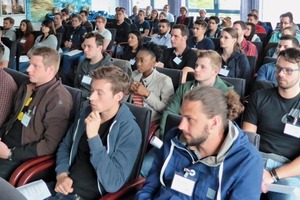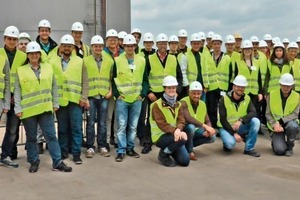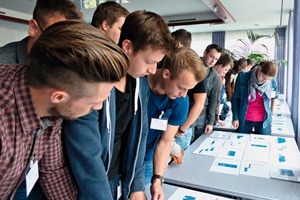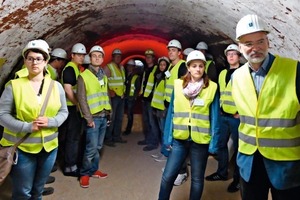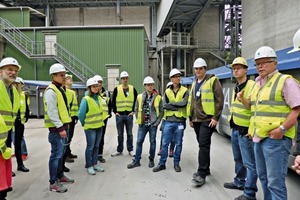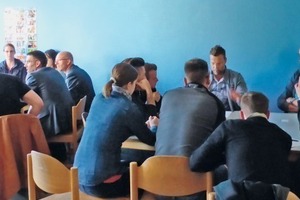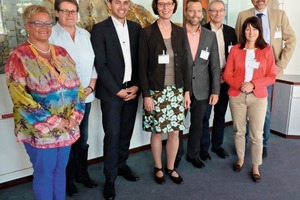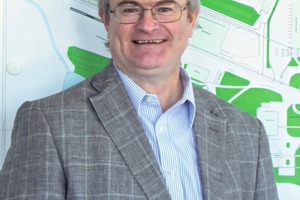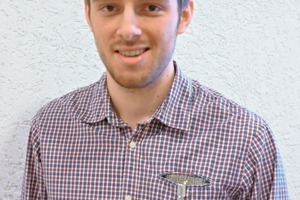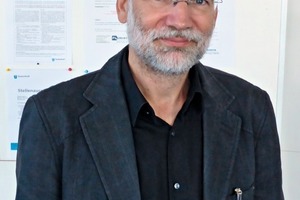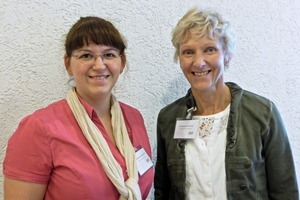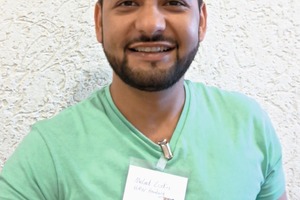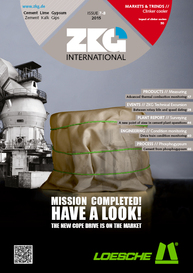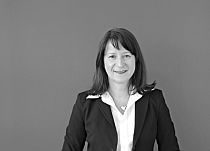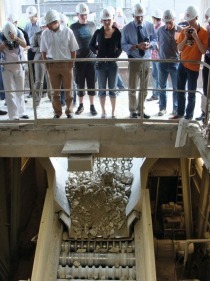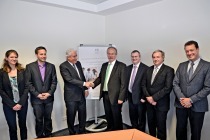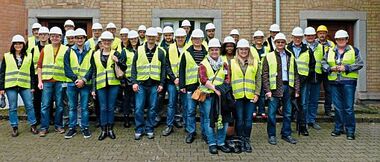Between rotary kiln and speed dating
The destination of ZKG’s field trip early this summer was the Dyckerhoff cement plant Lengerich, one of the Buzzi Unicem Group’s largest operations. Forty-five students and their mentors were happy to accept an invitation by ZKG International and several participating industrial partners to take this study tour to northwestern Germany on the 9th and 10th of June. The visitors hailed from the mechanical engineering and economics departments of Koblenz University of Applied Sciences, the process engineering and mineral resources departments of Bochum Technical University of Applied Sciences/TFH, and the mechanical process engineering department of Hamburg University of Applied Sciences/HAW.
Cement production process in theory and practice
Following a word of welcome by Anett Fischer, Editor-in-Chief of ZKG International, the students received an introduction to “The cement-making process at Lengerich Cement Plant”. Franz-Josef Barton, General Manager of Dyckerhoff’s northern-sector plants, recounted his own professional background as an example of what a career in the cement sector can look like. Established in 1872, Lengerich Cement Plant produces eleven types of cement for all major applications in civil engineering and general construction, plus a range of special-purpose binders, masonry cement and lime. The plant’s banner product, though, is oil-well cement, which was being sold and supplied to 64 countries in 2013. Barton also stressed the fact that Dyckerhoff’s most important capital is its employees. Roughly 10 % of the Lengerich plant’s workforce of 220 are apprentices. And since Dyckerhoff is always on the lookout for young engineers, the company was immediately amenable to hosting the ZKG field trip.
The plant’s Production Manager Ingo Sosna explained the cement production process all the way from the quarry to the hammer crusher and on to the blending bed. The crushed limestone is mixed with sand, gypsum, clay or iron ore and pulverized in a raw mill. After calcining in a six-stage heat exchanger (preheater tower), the material is transferred to a rotary kiln for firing into cement clinker and subsequent transfer to clinker silos. Following final comminution in ball mills and a period of temporary storage, most of the product leaves the plant as bulk goods, partly by rail, while about 35 % is bagged at the plant’s packaging unit. Oil-well cement is filled into 1.5-ton big bags by means of a special filling system. The plant’s annual investment volume amounts to several million €. Its special investments have included a new kiln line (#8) in 2001, which cost approximately € 125 million, and a new slag sand grinding system in 2008.
Having taken in all the details of the process, the students then had a chance to test their knowledge. Split up into several groups, they were tasked with arranging the procedural diagrams in the proper order, preferably more quickly than the other groups. In the end, two groups proved to be not only really fast, but also very accurate. Finally, with a little help from Ingo Sosna, all of them managed to correctly place the rotary kiln downstream of the raw mill.
During the lunch break at the plant’s canteen, the students made good use of the opportunity to talk shop with their industrial partners. Then, two groups were formed for a tour of the plant with experienced guides. The students found the excursion very interesting, and everyone was impressed by the inside view of a decommissioned rotary kiln. The climax of the tour, though, was the marvellous view of the surrounding countryside from the 108 m-high preheater tower, including a good look at the limestone quarry located directly beside the plant.
Conveying, weighing and proportioning
With these impressions, the event moved on to its theoretical part. Anne Passen, Aumund Fördertechnik GmbH, informed the visitors about the “Optimization of conveying routes in the cement-making process”. She described a pendulum bucket conveyor that can handle different kinds of material at the same time. Equipped with multiple loading and unloading stations, it offers major application potential. Anne Passen also gave the students a rundown on her company’s history and described the career opportunities now being offered by the Aumund Group. By way of examples, she sketched out various options for diploma, bachelor and master theses. Aumund’s axiom is that “you needn’t re-invent the wheel”, just put existing components from other conveyors to intelligent new uses. This harbours a lot of research potential for young engineers.
Martin Bollongino, Schenck Process GmbH, discussed “Weighing and proportioning technology in the cement industry”. He stressed the fact that the flow of materials requires accurate proportioning and supervision in order to compensate for differences in raw material quality. Bollongino surveyed the various types of scales and weighers, from static to continuous, with the latter type being encountered most frequently at cement-making plants. Proportioning belt weighers, for example, with their simplicity of design and low-cost production, are standard equipment in the cement industry. Bollongino offered a number of examples on how to design them for handling different materials. Bollongino told the students that his globally active employer covers all steps of weighing and proportioning in the cement-making process, and that Schenck Process does business not only in the cement industry, but also in such areas as mining, chemicals and transportation.
Job board and speed dating
One of the event’s goals is to network the participating companies and students. So, in addition to a job board, where the companies were able to post their open positions and bachelor- or master-thesis topics, the evening barbecue included a speed dating session. Split up into five groups, the different companies’ representatives welcomed the opportunity to introduce themselves and answer the students’ questions. That went down very well with everyone and helped establish mutual contacts.
Wear protection, proportioning
and refractory materials
On day two, Marc Doeffer, Köppern GmbH & Co. KG, opened the session with a paper on “Innovative wear prevention for roller presses”. First, though, he told the students a little about the 100-year-old family-run company and how it makes roller presses for use in milling clinker. With roller widths up to 2 m and roller diameters up to 2.4 m, the presses can weigh as much as 500 tons. They are operated by motors with ratings in excess of 4000 kW. Since conventional anti-wear measures have certain drawbacks, Köppern devised a new product called the Hexadur wear protection system, which features the use of customer-specific tribomaterials, optimized product intake behaviour via an autogenous wear protection layer and constant throughput. The system requires no in-service maintenance. Marc Doeffer concluded his presentation with a quite detailed account of his own personal career development – something that was very well received by the students.
“Highly consistent proportioning of combustion-process fuel and other proportioning applications in the cement-making process” was the subject of a presentation by Peter Norek, FLS Pfister GmbH. Founded in 1894, his company specializes in products for the cement-making and power generating industry. Norek presented an overview of the company’s well-known proportioning rotary packers for diverse applications, one of which is the proportioning of alternative fuels for the cement-making process. Pfister provides not only the checkweigher, but entire solutions to cover storage, proportioning and even pneumatic conveyance. Consistent weighing and blending of fuels are important processes at any cement factory. Then, Norek described the company itself, which, with a workforce of 500, offers a diverse global range of opportunities for college graduates, including some at its parent company FLSmidth.
Dr. Ulrich Zielinski, Refratechnik Cement GmbH, presented the last technical paper, entitled “Refractory materials – innovations for the cement industry”. Refratechnik, a family-owned enterprise established in 1950, develops a steady stream of new products to cope with changing requirements in the cement-making industry. The increasing use of alternative fuels is placing new demands on refractory materials and their ability to withstand chemical exposure. For each refractory lining, Refratechnik analyses the individual requirements, then develops and tests the most appropriate solution for subsequent serial production. At nine locations, Refratechnik Cement GmbH produces more than 450 000 t/year and offers a broad field of activity for engineers.
Thomas Zlaugotnis, representing Dyckerhoff’s operative personnel development unit, closed out the session with a talk on human resource development at Dyckerhoff. The company offers a range of individual options such as seminar programs, leadership development programs, etc. His colleague Steffi Fischer described her own path of development to show the students an additional available career alternative.
Speaking on behalf of all the participating universities, Prof. Dr.-Ing. Martin Geweke, from Hamburg University of Applied Sciences thanked everyone for helping to make the event so successful. For the students, he said, it is important to gain insight into the technical side of the cement-making industry and its suppliers. The ZKG field trip presented a very good opportunity to get to know each other and swap notes.
He also thanked the industrial partners, without whose contributions this event would not have been possible, and Lengerich Cement Works for providing such comprehensive support. Together, we were able to give all these future junior managers a chance to get a taste of the cement-making and ancillary industry and to establish some initial contacts.

